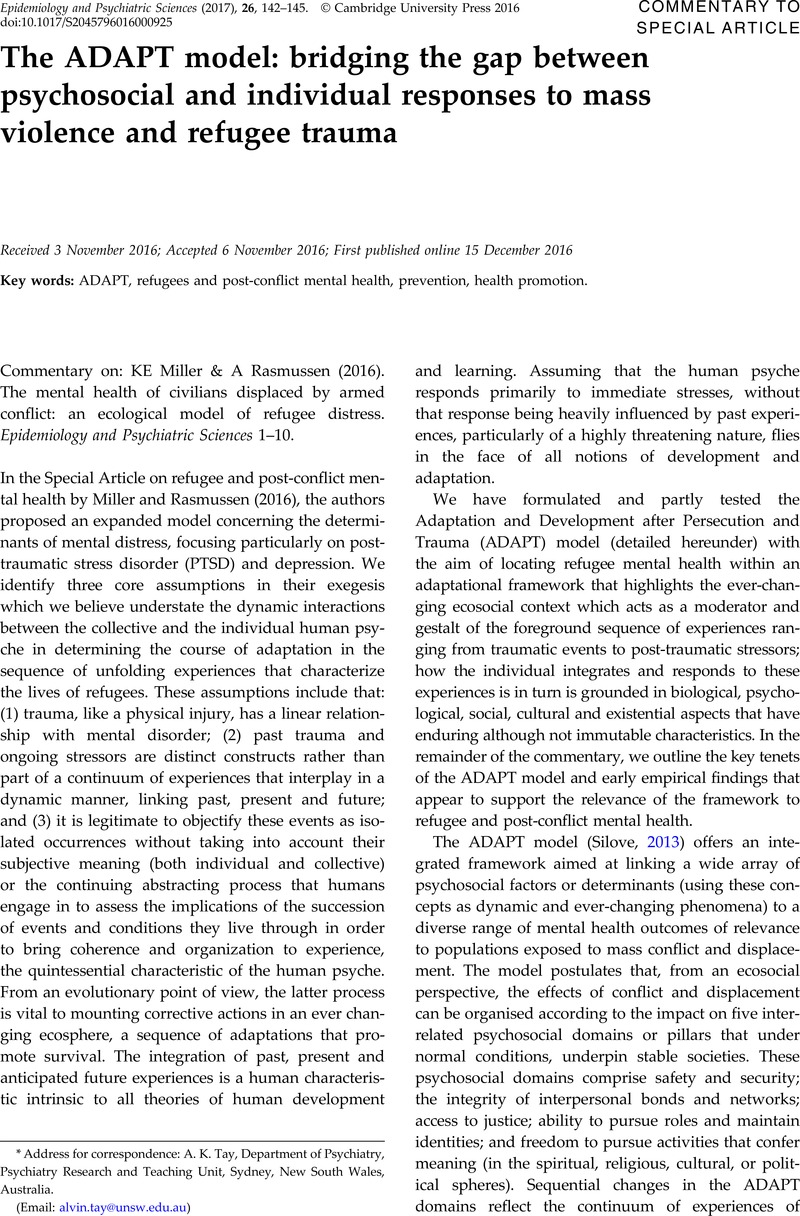Crossref Citations
This article has been cited by the following publications. This list is generated based on data provided by Crossref.
Tay, A K
Jayasuriya, R
Jayasuriya, D
and
Silove, D
2017.
Twelve-month trajectories of depressive and anxiety symptoms and associations with traumatic exposure and ongoing adversities: a latent trajectory analysis of a community cohort exposed to severe conflict in Sri Lanka.
Translational Psychiatry,
Vol. 7,
Issue. 8,
p.
e1200.
Silove, Derrick
Tay, Alvin Kuowei
Kareth, Moses
and
Rees, Susan
2017.
The Relationship of Complex Post-traumatic Stress Disorder and Post-traumatic Stress Disorder in a Culturally Distinct, Conflict-Affected Population: A Study among West Papuan Refugees Displaced to Papua New Guinea.
Frontiers in Psychiatry,
Vol. 8,
Issue. ,
Nasıroğlu, Serhat
Çeri, Veysi
Erkorkmaz, Ünal
and
Semerci, Bengi
2018.
Determinants of psychiatric disorders in children refugees in Turkey’s Yazidi refugee camp.
Psychiatry and Clinical Psychopharmacology,
Vol. 28,
Issue. 3,
p.
291.
Haans, Anthony
and
Balke, Nora
2018.
Trauma-informed intercultural group supervision.
The Clinical Supervisor,
Vol. 37,
Issue. 1,
p.
158.
Wells, Ruth
Lawsin, Catalina
Hunt, Caroline
Said Youssef, Omar
Abujado, Fayzeh
and
Steel, Zachary
2018.
An ecological model of adaptation to displacement: individual, cultural and community factors affecting psychosocial adjustment among Syrian refugees in Jordan.
Global Mental Health,
Vol. 5,
Issue. ,
Mahmuda, Mahmuda
Miah, Mohammad AbdulAwal
Elshazly, Mohamed
Khan, Sanjida
Tay, AlvinKuowei
and
Ventevogel, Peter
2019.
Contextual adaptation and piloting of Group Integrative Adapt Therapy (IAT-G) amongst Rohingya refugees living in Bangladesh.
Intervention,
Vol. 17,
Issue. 2,
p.
149.
Almoshmosh, Nadim
Jefee Bahloul, Hussam
Barkil-Oteo, Andres
Hassan, Ghayda
and
Kirmayer, Laurence J.
2019.
Mental health of resettled Syrian refugees: a practical cross-cultural guide for practitioners.
The Journal of Mental Health Training, Education and Practice,
Vol. 15,
Issue. 1,
p.
20.
Tay, AlvinKuowei
Miah, Mohammad AbdulAwal
Khan, Sanjida
Badrudduza, Mohammad
Alam, Rofique
Balasundaram, Susheela
Rees, Susan
Morgan, Karen
and
Silove, Derrick
2019.
Implementing Integrative Adapt Therapy with Rohingya refugees in Malaysia: a training-implementation model involving lay counsellors.
Intervention,
Vol. 17,
Issue. 2,
p.
267.
Tay, Alvin Kuowei
Khat Mung, Hau
Badrudduza, Mohammad
Balasundaram, Susheela
Fadil Azim, Darlina
Arfah Zaini, Nur
Morgan, Karen
Mohsin, Mohammed
and
Silove, Derrick
2020.
Psychosocial mechanisms of change in symptoms of Persistent Complex Bereavement Disorder amongst refugees from Myanmar over the course of Integrative Adapt Therapy.
European Journal of Psychotraumatology,
Vol. 11,
Issue. 1,
Shepherd, Dean A.
Saade, Fouad Philippe
and
Wincent, Joakim
2020.
How to circumvent adversity? Refugee-entrepreneurs' resilience in the face of substantial and persistent adversity.
Journal of Business Venturing,
Vol. 35,
Issue. 4,
p.
105940.
Tay, A. K.
Miah, M. A. A.
Khan, S.
Badrudduza, M.
Morgan, K.
Balasundaram, S.
and
Silove, D.
2020.
Theoretical background, first stage development and adaptation of a novel Integrative Adapt Therapy (IAT) for refugees.
Epidemiology and Psychiatric Sciences,
Vol. 29,
Issue. ,
Tay, Alvin Kuowei
Mung, Hau Khat
Miah, Mohammad Abdul Awal
Balasundaram, Susheela
Ventevogel, Peter
Badrudduza, Mohammad
Khan, Sanjida
Morgan, Karen
Rees, Susan
Mohsin, Mohammed
Silove, Derrick
and
Spiegel, Paul B.
2020.
An Integrative Adapt Therapy for common mental health symptoms and adaptive stress amongst Rohingya, Chin, and Kachin refugees living in Malaysia: A randomized controlled trial.
PLOS Medicine,
Vol. 17,
Issue. 3,
p.
e1003073.
Jiang, Yi Dragon
Straub, Caroline
Klyver, Kim
and
Mauer, René
2021.
Unfolding refugee entrepreneurs' opportunity-production process — Patterns and embeddedness.
Journal of Business Venturing,
Vol. 36,
Issue. 5,
p.
106138.
Tay, Alvin Kuowei
Miah, Mohammad Abdul Awal
Khan, Sanjida
Mohsin, Mohammed
Alam, A.N.M. Mahmudul
Ozen, Sanem
Mahmuda, Mahmuda
Ahmed, Helal U.
Silove, Derrick
and
Ventevogel, Peter
2021.
A Naturalistic Evaluation of Group Integrative Adapt Therapy (IAT-G) with Rohingya Refugees During the Emergency Phase of a Mass Humanitarian Crisis in Cox's Bazar, Bangladesh.
eClinicalMedicine,
Vol. 38,
Issue. ,
p.
100999.
Kronick, Rachel
Jarvis, G. Eric
and
Kirmayer, Laurence J.
2021.
Refugee mental health and human rights: A challenge for global mental health.
Transcultural Psychiatry,
Vol. 58,
Issue. 2,
p.
147.
Wood, Benjamin
and
Kallestrup, Per
2021.
Benefits and Challenges of Using a Participatory Approach with Community-based Mental Health and Psychosocial Support Interventions in Displaced Populations.
Transcultural Psychiatry,
Vol. 58,
Issue. 2,
p.
283.
Whitaker, Louise
Hughes, Mandy
and
Rugendyke, Barbara
2021.
Capturing Practice Wisdom: Advancing the Empowerment of Women from Refugee and Migrant Backgrounds.
The British Journal of Social Work,
Vol. 51,
Issue. 4,
p.
1296.
Dubus, Nicole
2021.
Once arrived: A qualitative study of refugees and service providers in the first six months of resettlement.
Journal of Social Work,
Vol. 21,
Issue. 4,
p.
774.
Mesa-Vieira, Cristina
Haas, Andreas D
Buitrago-Garcia, Diana
Roa-Diaz, Zayne M
Minder, Beatrice
Gamba, Magda
Salvador, Dante
Gomez, Daniel
Lewis, Meghann
Gonzalez-Jaramillo, Wendy C
Pahud de Mortanges, Aurélie
Buttia, Chepkoech
Muka, Taulant
Trujillo, Natalia
and
Franco, Oscar H
2022.
Mental health of migrants with pre-migration exposure to armed conflict: a systematic review and meta-analysis.
The Lancet Public Health,
Vol. 7,
Issue. 5,
p.
e469.
Garrick, Jacqueline
and
Buck, Martina
2022.
The Psychosocial Impacts of Whistleblower Retaliation.
p.
167.




Target article
The mental health of civilians displaced by armed conflict: an ecological model of refugee distress
Related commentaries (2)
An ecological model for refugee mental health: implications for research
The ADAPT model: bridging the gap between psychosocial and individual responses to mass violence and refugee trauma